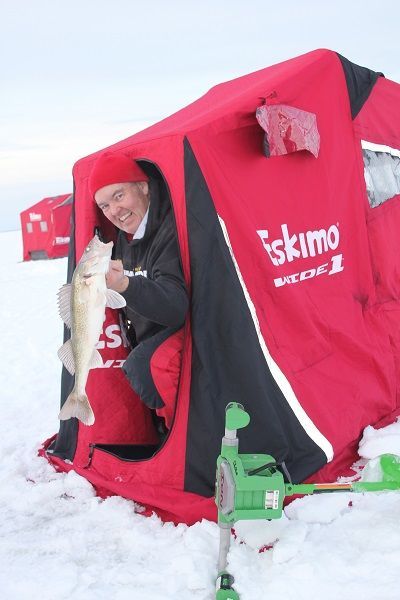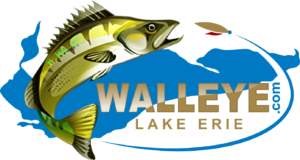Walleye.com
Lake Erie Info
Fishing Reports
Main Fishing Reports & Forums
Ohio DNR Weekly Fishing Report
Lake Erie United Fishing Reports
Lake Erie Weather
Great Lakes Marine Forecasts
NOAA Erie Graphical
NWS Lake Erie
Sandusky, OH Accuweather
Lake Erie Web Cams
Lakevision Web Cams
Toledo, OH Web Cam
Cleveland, OH Web Cam
Cleveland (3.5M Offshore Crib)
Eastlake, OH Web Cam
Lake Erie Conditions
Lake Erie Water Temperatures
NOAA Nearshore
NOAA Open Lake
NOAA Buoys
Coastwatch Satellite Images
Coastwatch Surface Temps
***********************
Visit the Walleye Tackle Store
Lake Erie Fishing Reports
Find Your Next Fishing Boat
Sell your Fishing Boat FAST!
Book a Fishing Charter
* Western Lake Erie Charters
* Central Lake Erie Charters
* Eastern Lake Erie Charters
Articles on Walleye Fishing
Movin Out for January Walleyes
 Good ice came earlier this season than it has in recent memory and was welcome news for those chomping at the bit to get it all started. In the northern part of the State anglers were even out before Thanksgiving on the shallower lakes like Red and the walleye action was red hot. If there is a downside to the early start it might be the possibility of the notorious mid-winter slump showing up a little sooner. Even so; January is still a great time to be on the ice and there are more opportunities right now for keeping your pole bent than at any other time during the hard water season.
Good ice came earlier this season than it has in recent memory and was welcome news for those chomping at the bit to get it all started. In the northern part of the State anglers were even out before Thanksgiving on the shallower lakes like Red and the walleye action was red hot. If there is a downside to the early start it might be the possibility of the notorious mid-winter slump showing up a little sooner. Even so; January is still a great time to be on the ice and there are more opportunities right now for keeping your pole bent than at any other time during the hard water season.
Access is the key and by now you should be able get just about anywhere you want to go. If that’s the case the next question is; where do you really want to go? Deciding on a starting spot can be a bit of a head scratcher especially on bigger water like Red, Winnibigoshish, or Lake of the Woods. There is just so much water to consider but for the most part you can eliminate the shallowest areas and concentrate your efforts well offshore, including the middle of the lake. On Winnie and Lake of the Woods you’ll probably be looking for deeper humps and bars and on Red you should just be looking for fish. Red is in a class all by itself and doesn’t have that much for structure and fish tend to roam in loose groups out in the middle of nowhere. The same thing can happen on LOW but the deeper humps and reefs will have fish on them and the structure isn’t that hard to find, not with today’s equipment. Global Positioning and electronic mapping has made it easy to get to potential hotspots without wasting any valuable fishing time. With a G.P.S like the Humminbird 597ci loaded with the LakeMaster chip you can easily navigate to all of that structure and even find the key spots that include little inside turns or points which can help to concentrate fish. The detail that LakeMaster provides is absolutely incredible and will allow you to uncover spots that you may have never found on your own.
Depending on ice and snow conditions you might be able to reach your destination in a vehicle but in all likelihood a sled or ATV will be more appropriate. Mobility is the key and lots of moves might be required and a portable shelter towed behind a sled is fast, faster than anything else. To help get me to the fish I’ll use the ‘Bird in the truck (if conditions permit), and then use it to navigate with the sled from there. The great thing about the 597 is that it has a large enough screen to see all of that detail while on the run and makes spot finding a snap. Spot finding doesn’t guarantee fish but it sure helps and you can either find and catch or simply eliminate water which is all part of the process.
Drilling a lot of holes is another part of the process and this year mine will all be cut with the Ion, which is a super-fast electric auger. In fact almost all of my holes last year were cut with the Ion which proved to be as fast as advertised, light, and completely dependable. You may not have to drill that many holes and will depend on how quickly you can find some fish. When you’re in the right area you’ll see fish at least come in for a look on the depth-finder and if you’re not; you better keep going. They don’t have to bite right away but they should at least show themselves. That means seeing good thick marks which on the 597 will be wide and red. The small stuff doesn’t mean all that much but it does show a sign of life and it could be baitfish you’re looking at which can be a good draw at the right time. When you look a spot over be sure to drill some holes on top and down the break in deeper water. Those deeper fish might be what you’re after and may come in and look and swim off if they’re not in the mood but be back with a vengeance later in the day.
Timing is everything when you’re trying to hook up with walleyes during a slowdown and having your lines in the water just before and just after dark is imperative. If you’ve been seeing fish and not catching don’t let that bother you, at least not yet. And if you saw good marks in deeper water don’t expect them to stay there during “prime time”. Typically; walleyes will stay deep until late in the day and then move up and in and is when they are most vulnerable.
Staying late means being warm and comfortable because if you’re not you’ll be headed home before the good stuff happens. And that’s why I’m using Eskimo’s Wide 1 Inferno which is a fully insulated shelter and believe me; insulation makes a huge difference. It eliminates condensation, is super quiet inside, and is much much easier to heat. It also has an expandable wide bottom that provides more than enough room for working two holes, a heater, and a depth finder.
Productive “slow-down” techniques still includes plenty of jigging spoons but a softer less aggressive approach might be more effective. Slower dropping spoons that flutter like the Northland Macho Minnow can also help put more walleyes on the ice. Float setups or set lines can also mean more hookups, especially when the fish are really off.
So where do we go from here? So many fish, so many spots, so little time. See you on the ice.
Ron Anlauf




